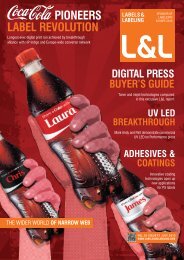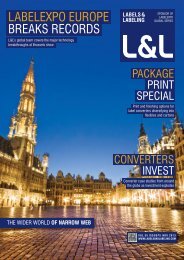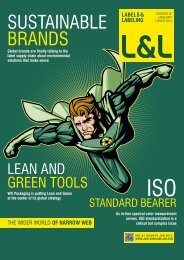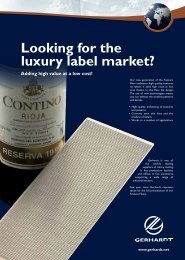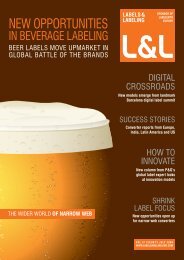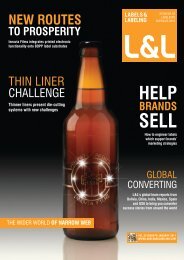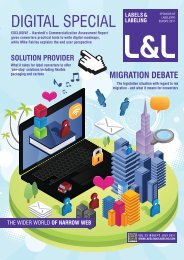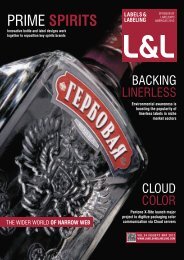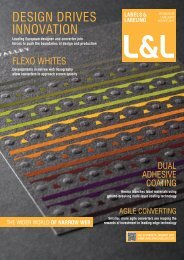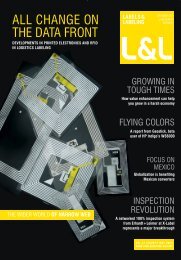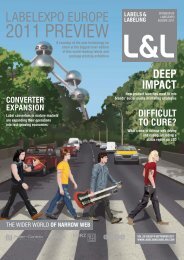You also want an ePaper? Increase the reach of your titles
YUMPU automatically turns print PDFs into web optimized ePapers that Google loves.
22 | L&L<br />
separation, thereby supporting PET and bottle-to-bottle<br />
recycling to become more efficient and of better quality, a<br />
point compounded by no adhesives being involved and no<br />
ink bleeding during the recycling process – as with traditional<br />
shrink sleeves.<br />
For Tim Richards, business development manager beverage<br />
Europe at CCL Label, Triple S stretch sleeve labels are a<br />
fantastic and far more sustainable option than shrink sleeves,<br />
and indeed many other forms of labeling. He explains, ‘Triple S<br />
sleeve labels are based upon LDPE film – and being essentially<br />
a new technology – do offer a very exciting new solution to<br />
environment and sustainability issues, amongst many other<br />
advantages.<br />
‘Indeed, I recently had a meeting with Closed Loop Recycling<br />
in Dagenham, England, in which they made a very strong<br />
appeal to us to help spread the word about just how beneficial<br />
and supportive LDPE stretch sleeves can be for the recycling<br />
process, increasing both the yield of re-won bottle material as<br />
well as improving the quality thereof.<br />
‘This is because from a recycler’s point of view, the optimum<br />
option is always total separation of the sleeve or label from<br />
the bottle which is often quite difficult in practice, beginning of<br />
course with the identification of the clear PET bottle whilst still<br />
covered by the full-body sleeve.’<br />
An additional environment and sustainability benefit of the<br />
stretch sleeves is that they offer a superior carbon footprint and<br />
a reduction in fossil fuel usage throughout their life-cycle (as<br />
examined by OFI and just last month validated by the Lenfest<br />
Center for Sustainable Energy, Columbia University USA).<br />
Indeed, one of the main findings of the Center – ‘that the<br />
product carbon footprint of the Triple S Super Stretch sleeve is<br />
about four times smaller than that of the standard shrink sleeve<br />
(see Fig. 2) – seems directionally correct and explained by<br />
the combination of less raw material (per sleeve) and lack of<br />
required shrink tunnel during labeing.’<br />
Stretch sleeves also offer significant energy and efficiency<br />
savings resulting from a leaner, cleaner application process<br />
(no shrink tunnel, no bottle drying). The extremely low density<br />
(0.91 gr/ccm) films allow the easiest and cleaner separation for<br />
recycling.<br />
‘In summary,’ says Richards, ‘the Triple S stretch sleeve<br />
technology we have introduced is highly competitive with<br />
other label materials (up to 40 percent cost savings), is highly<br />
efficient and, when used with, say, Sleevematic ES application<br />
machinery from Krones AG, provides for a short investment<br />
payback (a ROI is possible within one year) and has low<br />
materials and utilities costs.<br />
‘Our aim is to strengthen the brand owner’s association with<br />
"stretch" rather than only with "shrink" when discussing sleeve<br />
labels in the market place, especially as a result of stretch’s<br />
superior environmental profile.’<br />
EXAMPLES of bottles decorated with Triple S stretch sleeves<br />
LABELS&LABELING



